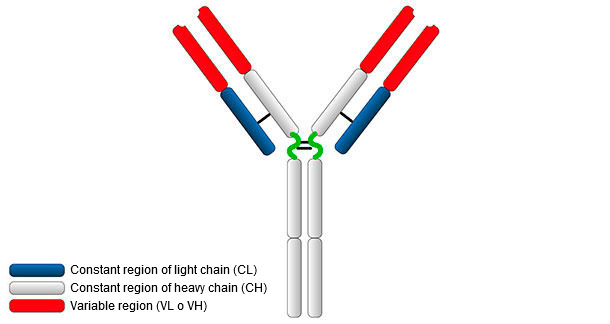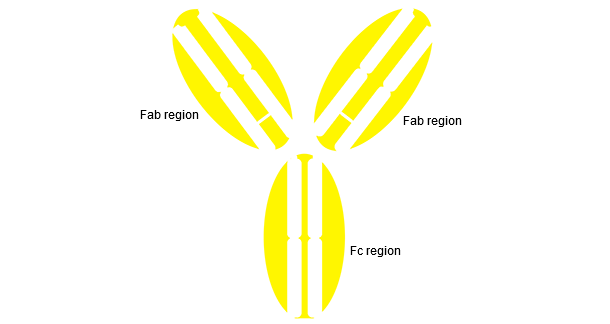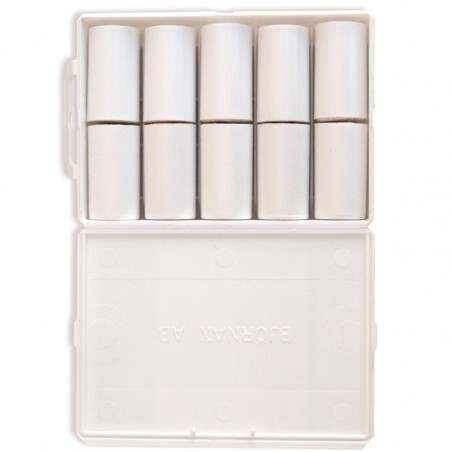Antibodies (Ab) or immunoglobulins (Ig) are:
- produced by antigen-stimulated B lymphocytes and differentiated in plasma cells (ASC: Antibody Secreting Cells);
- secreted in extracellular body fluid;
- able to bind and attack foreign pathogens and neutralize and eliminate them through multiple mechanisms.
The immunoglobulin monomer has a molecular weight of 150-180 kDa and is roughly Y shaped (Figure 1).

Figure 1. Overall structure of an immunoglobulin.
The typical structure of Ig consists of two heavy chains (H: "heavy") and two light chains (L: "light") bound by disulfide bonds. Both chains have two portions, a constant region (C), and a variable region (V).
The H and L chains have regions or domains where the protein folds to form a globular area, called VH, CH and VL, CL, respectively. Heavy chains are formed by a variable part (VH) and three (for IgG and IgA) or four constant (for IgM and IgE) domains called CH1, CH2, CH3 and CH4. The light chain may be either λ or κ type and is formed by two domains, one variable (VL o VK) and another constant (CL or CK). VH and VL domains have highly variable regions called "Complementary Determining Regions" (CDRs) that represent the antigen-specific site of each antibody.
There is a between CH1 and CH2 which permits the flexibility of Ig molecules. The digestion of the hinge region with proteases leads to two Fab fragments (containing the antigen-binding site) and one Fc (cristallizable Fragment) involved in the antibody functions.
CH2 and CH3 domains are the binding sites for the Fc receptors, while CH1-CL domains bind the complement fragment C4b and the CH2 domain binds the factor C1q of the complement
A bacterium possesses different surface epitopes; during an infection, different antibodies will be produced and each antibody will bind to its specific epitopes on the pathogen.
The different amino acid sequences of the constant heavy chain region characterize different classes of antibodies or isotypes (Figure 2): IgD (heavy chain δ), IgM (heavy chain μ), IgG (heavy chain γ), IgA (heavy chain α) and IgE (heavy chain ε). IgM are secreted as pentamers and IgA as secretory dimers.

Some Ig subclasses with different heavy chains, have been described, mainly among the IgG and IgA classes.
The different antibodies are the effectors of humoral immunity against infectious agents and, therefore they are present in high concentrations in serum and in other biological fluids (mucosal secretions (e.g. saliva), milk, colostrum, etc.). The defensive role of antibodies is due to different mechanisms (described in the 2nd part of the article)
IgG are immunoglobulins with a molecular weight of about 108 kDa. IgG immunoglobulins are in greater quantities in serum and in extravascular spaces. IgG are primarily involved in the systemic defensive response. They are effective in the neutralization of viruses, in the interaction with the C1 fraction of complement and in activating the complement cascade with opsonization and phagocytosis of pathogens. Moreover, they promote the killing of infected cells by means of Antibody-dependent Cellular Cytotoxicity (ADCC reactions). The pig has six IgG subclasses, from IgG1 to IgG6.
IgM monomers with a molecular weight of about 108 kDa, are attached to the B cell surface and have a role as BCR (B Cell Receptor) for B cell antigen recognition. The secreted IgM form is a pentamer with a circular shape in which five monomer subunits are held together with disulfide bonds and a J chain; this pentameric form has about 900 kDa of molecular weight.
IgM is the first immunoglobulin synthesized at the first contact with the antigen. It is secreted mainly in the primary humoral immune response for a first and important defense against viral and bacterial infections. Specific IgM against a pathogen in the serum indicates recent/acute infection. They are also secreted during the secondary response, but in a smaller quantity. In this form, Fc regions are in the center with ten antigen binding sites at the periphery. IgM are able to bind more molecules of the C1 fragment for classical pathway and are highly efficient in activating complement for opsonization, as well as in the neutralization and agglutination of viruses.
The so-called natural IgM antibodies (NAs: "Natural Antibodies" - IgM) are produced by some subsets of B lymphocytes that may be involved as first-line defense against the systemic spread of infectious agents.
IgA is the predominant Ig class in secretions (saliva, mucus, tears, colostrum, milk) at mucosal surfaces and prevent the penetration and colonization of pathogens.
IgE is an immunoglobulin of about 190 kDa of molecular weight and is present at low concentration in blood. Immunoglobulins IgE are specifically involved in type I hypersensitivity and in the defense against parasites.
IgD monomer has a main role as BCR.












